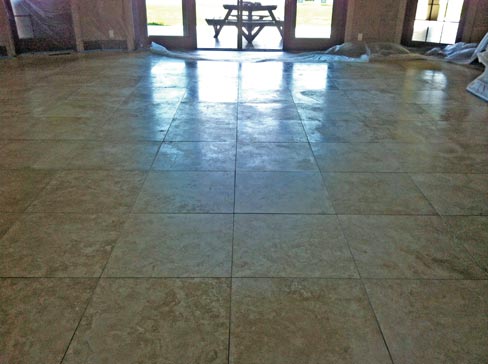The Polished Perspective: On Top of Your Game
Tom McNall, Floor Restoration Consultant
 To seal or not to seal is not the question today. Nor is it how to seal (well maybe), but more specifically, what are you sealing? How are you sealing it and just how much sealing is truly enough?
To seal or not to seal is not the question today. Nor is it how to seal (well maybe), but more specifically, what are you sealing? How are you sealing it and just how much sealing is truly enough?
Whether the questions come to me from architects, designers, homeowners, janitorial newbies or longtime tile guys, everyone has heard horror stories about needing to seal stone 2-3 times when installed and every 6 months thereafter for eternity. And when I answer, everyone gives me that dumb look with their head twisted to the side as if to ask, “Are you sure?” What kind of answer could I give them that causes so much confusion?
First things first; sealers used in the stone industry are actually known as “impregnating sealers,” as opposed to “topical” products that most people think of in general when they hear the term “sealers.”
Picture this: When you impregnate, you have to put something “inside” something else. This is why unborn human babies always grow “within” the mother’s womb, not outside. Is everyone following along here? With stone, the seal actually takes place (or should take place) within the stone – not on the outside (or topside which is the most often exposed side - especially with floors). However, not everyone reads the label, nor do all labels explain this procedure properly.
A topical sealer sits on “top” of the surface it is sealing – imagine that. However, in the average stone user/producer/seller’s (and so on) defense, I have yet to see a topical sealer labelled as such. They typically are sold simply as “sealers” which probably helps confuse those who start to think of sealing within the stone industry. But if you are reading this, I have a feeling that you may already be in the stone business or soon to be. Either way, remember this: Impregnate = IN and; Topical (AKA just sealer) = ON! Stone people should only use impregnating sealers.
Now we get to the, “Are you sure?” part of the confusion. Yes, I am sure. In the 1990s, the NTC (National Training Center for Stone and Masonry) did a study on maintenance of coated stone and impregnated stone. They found that regular maintenance of stone by janitorial staff that was previously coated (sealed) had 2-4X the regular daily maintenance. That fact alone should discourage the practice but there are far more superior reasons for using the proper sealer and applying it in the right manner.
Coated stone can and will spall, coatings will scratch, yellow, peel, flake and dull very quickly (requiring more coatings and maintenance). And to top it off, a coated stone looks like plastic, and to me–that is just offensive! Why would an end user of an expensive, luxurious covering product want to pay stone prices for plastic finishes? Think about it.
Now, let me get to the further consequences of coating stone. Have you ever tried to remove an impregnating sealer that was coated on a stone? If you have, you’ll know where this is going. If you haven’t, you are going to wish that I am wrong. The best impregnating sealers are exactly the best because they are meant to never wear – because they are supposed to be beneath the surface, not on it, remember?
Without pretending to be a chemist (because I am not), I do know, however, that these sealers cannot be stripped off of the surface with your average janitorial supply house wax stripper. Most impregnators that are applied on the stone and need to be removed will need to be stripped off by some of the nastiest chemicals known to man. Not only are they hazardous to humans and any other oxygen breathing organism, but they do the ground and water tables no favors either. Any chemical that will eat through stone sealers, may and could eat through rubber-soled shoes, gloves, skin and the list goes on.
Far better is it to apply sealers correctly and only when required. So when, then, is sealing required?
Generally, only about 10% of granites need sealing. And maybe 15-20% of marbles and 25% of limestones will need sealing. And of that minority, perhaps 10% will require a second application. How would you know which ones require sealing? It’s pretty simple really.
Are you ready for the secret? Wet the stone for five minutes then wipe it off. If the stone stays dark for 30 seconds or more, then that stone needs to be sealed. If it returns to its original color after the water residue evaporates, then nothing water-based will stain it, anyway (and does not require a protector).
For oil-based stains, do the same test with mineral spirits. Again, if the stone stays dark after the residue is removed, then seal it. It’s just that simple.
And if you want to know if it requires a second application (not coating – there’s a difference), you will know if the stone sucks up the sealer from your first wet application within five minutes. If it does, re-apply. If your stone is properly sealed (if it needs it at all) from installation, you should not need another application for 10-15 years, as long as the stone does not get traffic like the Brooklyn-Queens Expressway does everyday. If you don’t get that kind of life out of your sealer, then you are using the wrong brand.
Until next month, keep your stick on the ice.
Tom McNall is founder and owner of Great Northern Stone, an Ontario-based stone cleaning and restoration company servicing Ontario and Chicago, IL. Tom also offers corporate and private consultations as well as speaking at conventions. He can be reached at stone_rx@earthlink.net.